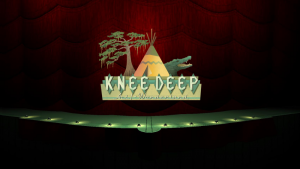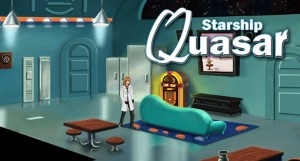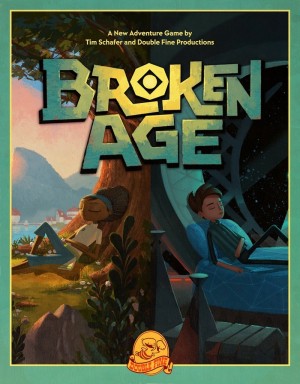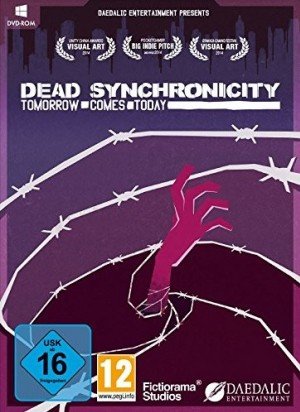Review for Knee Deep page 3
Game information
Take me straight to Act 3 - Boomtown!
Act 1 - Wonderland
When I first heard about the episodic Knee Deep, I was very interested to see what Prologue Games would be able to do with their modern murder mystery set in the swampy backwoods of Florida. The story held a lot of promise, and I was more than a little intrigued by the game’s presentation, performed as a live theatrical production, complete with set changes and audience feedback. Fast forward a few months to Act 1 – Wonderland, and I must report that my bar may have been set a little too high. Knee Deep’s first act debut is a quirky but entirely too one-dimensional game that requires minimal player input and waits until the final moments to show potential for something better in store in the two remaining acts of this planned trilogy.
From the very beginning, Knee Deep quite literally sets the stage: you are an audience member, settling in for a performance at the theater, and before the game even begins you’re given the task of handling some last-minute pre-show business, like reading the playbill and silencing your phone. As you advance into the game proper, a spotlight comes on, illuminating a lone figure dangling at the end of a rope from a roadside attraction tower. Below, a janitor sweeping up for the evening glances up and catches sight of the gruesome spectacle. Tag Kern, a once-famous movie star, now resigned to forgettable roles in second-rate films, has apparently chosen the backwater town of Cypress Knee, once a tourist trap but now as washed-up as Kern himself, as the site for his final public appearance.
As word of the apparent suicide gets out, three key individuals find themselves dispatched to Cypress Knee to investigate. During the game, players will take control of Romana Teague, an online blogger always looking for the next hot story; newspaper reporter Jack Bellet, who is struggling to remain relevant in a print-dead world; and K.C. Gaddis, a private investigator hired by Kern’s movie studio to ascertain the details behind his death for their insurance payout.
As each character investigates, they’ll travel to various locales within Cypress Knee and interact with a host of the town’s citizens, all while remaining on the theater stage. The way this is achieved in-game was one of the things that initially attracted me to the look of the game. Individual locations exist more or less in a vacuum, with perhaps three or four visible on-stage at any one time, lit in spotlights and separated by seas of darkness – we understand that in reality they’d be miles apart. Many locations, like the convenience store, motel, and tour bus of the local chapter of a religious group clearly meant to lampoon Scientology, may be on-stage at any time.
When the player approaches a building to enter it, it literally unfolds itself, opening up in a clever way that brings the audience past its brick-and-mortar walls and reveals its insides, then folds back up and is swallowed by darkness when you move to a new location. A sort of gimbal system lets locations be rotated on and off the stage while our cast remains present. In short, much like in a real stage production, rules of space-time don’t exist in this metaphysical representation. Occasionally, characters find themselves in some sort of law enforcement interrogation room, being questioned about the events transpiring in the game, letting us know that the plot, in essence, is a flashback to events that have already taken place.
I quite like the ideas at work in adapting a true-to-life murder investigation with various places into a stage-friendly production. However, the cleverness apparent in the production design is quickly overshadowed by the game’s glaring lack of anything for players to do. To call Knee Deep “linear” would be an understatement; not only do you have zero input on where to go next, you aren’t even in charge of actually getting there. Much like an actual theater audience, you passively watch characters move about on stage, going from place to place and performing their actions. The investigation moves ahead completely on its own, with no input from you. Every once in a while, you may have a choice between which of two possible locations to visit first, though the order has no bearing on the outcome of the story, and once your character has completed the dialog at your chosen location, he or she moves on to the remaining one automatically.
There are only two ways in which players can participate in Knee Deep. The first is fairly commonplace these days: choosing conversation responses. During most conversations, you’ll be given a choice of three responses to the current situation, with one often being “Make a strange response”. While that’s not terribly informative, I often found the other two choices to be just as mystifying. For example, the first time we meet Romana Teague near the game’s outset, she’s sitting in her car stuck in traffic. Suddenly, we’re given three responses to choose from: “Fanrage”, “Cypress Knee”, and “Give a Strange Response”. However, there is no conversation occurring at the moment, and a first-time player will have no idea that Fanrage is, in fact, the blog for which Romana writes. Without further explanation, you’ll pick one and the game moves on.
Then there are times you’re forced to decide between different choices concerning characters’ backstories. For instance, when two particular people cross paths at one point in the game, their reaction to each other is far from friendly, and it’s clear they have some shared history. A moment later, a conversation about their animosity ensues, and players are given some options as to what actually transpired between them, without knowing the background or surrounding circumstances. While this provides a sense that you’re creating your own story details as you see fit, I would have appreciated it more if it felt more vital to the actual story (which it doesn’t) and if I wasn’t again having to choose from two or three cryptically-named choices – I want to be able to choose responses to events in a way that’s consistent to the characters’ motives, but can’t do that when I’m blindly interpreting what a specific choice might refer to. There is one instance near the very end of this first episode where players make a life-and-death choice, which seems like the kind of decision that could impact the game moving forward on a more important level, though whether this has any implications other than cosmetic ones remains to be seen in the next installment.
Apart from clicking through dialog and making (sometimes) random conversation guesses, the only other real piece of gameplay occurs when the protagonists have to submit written updates to their bosses, usually right before the game switches to the next character, which happens about six times during the course of the episode. In the cases of Romana and Jack, you will need to choose a story blurb to send to their editors, while K.C. Gaddis submits an update on his investigation to the movie studio execs. Regardless of who you’re controlling at the moment, this system works the same for everyone: you’ll select a new development in the case from your journal, based on your conversations with others, typically whichever seems the most relevant. Then you’ll select how it should be worded, choosing between “cautious”, “edgy”, and “inflammatory” styles, which all include the same information but with varying degrees of acridity. Depending on which you choose (much like your dialog options), certain townsfolk may feel friendlier or more alienated toward you.
This is pretty much the extent of the player’s role in Knee Deep, and it definitely won’t be for everyone. There are no inventory items to gather and use whatsoever, nor do you control the actions of the characters. Late in the game there are two bog-standard puzzles to solve – one to reassemble scraps into a coherent picture, the other to place tiles in a fuse box in a way that connects all same-colored wires together – but by that point in the experience they feel like the odd exception awkwardly shoehorned in rather than a welcome change in direction that makes up for the lack of interactivity up ‘til then.
Looking past the limited amount of player interaction, I found it hard to get truly sucked into Knee Deep’s murder plot. I think, for one thing, the developers are taking on more than they can handle by introducing a small town’s worth of one-dimensional characters in rapid-fire succession. It’s hard enough to distinguish between three separate protagonists (none of whom are overwhelmingly interesting), each revisiting the same locations and interacting with the same people. You’ve barely understood who the current protagonist is by the time you’re interrogating the townsfolk. As each conversation ends, it is quickly replaced by the next one, with another person to meet.
And so it goes, one after another, and soon you’ll have completely lost track of who is who. It can be fairly difficult to recall enough about a character when they’re mentioned in later conversations, and to keep track of the number of dots you’re asked to connect. Add to this the fact that the plot keeps pulling away from the actual murder angle (political small-town machinations, corporate greed, environmental activism) and the forced attempts at humor (like the town councilman who’s always getting his homophones mixed up, or the assessment you can take to see how fit you are for the local religious cult), and the whole experience becomes rather dull.
The journal you’re given does keep track of the characters you’ve met and discoveries made during the game, but on the whole I found it a bother to attempt to slog through its poorly-designed interface. Only two of its three tabs, “Clues” and “Lore”, contain any information you may need (the third being “Achievements”). But each tab is then further split up into sections, either by playable character or by townsperson who provided the clue. Wading through these various submenus just to find a one-sentence description of a person was often more trouble than my already-tepid interest level was willing to endure. In the end, possessing a clear understanding of Cypress Knee’s inner workings seemed only marginally important at best, as the story takes an abrupt left turn near its conclusion. Perhaps I’ll be motivated to refresh my memory during a future episode?
I’ve talked about the inventive set designs used in Knee Deep, but that’s really saying nothing about its actual graphics, which, much like its musical score, fail to impress on a basic level. In short, there’s not much to look at. The sets are understandably minimalist, and with their larger-than-life pastel designs they work in the context of a stage show about a decaying Florida swamp town. But the actual people inhabiting Cypress Knee are decidedly less excusable; one and all look like vaguely human blobs stuffed into clothing, with odd shapes and padded curves in all the wrong places. Between grey skin tones, wooden mannerisms, and lack of any distinguishing marks or features, it all exacerbates the problem of telling one apart from the rest. But if the characters are bland, the soundtrack is nearly nonexistent during large portions of the game. Never a good sign, the sound of crickets chirping (or is it cicadas?) is often the only thing you’ll hear, with occasional plucked strings and the treat of a more fully formed song on rare occasions. I guess it fits in with the overall themes of dilapidation and isolation, but it’s certainly not pleasant or fun to listen to.
And so we have a first episode with a uniquely creative premise, which in practice gives short shrift to any actual fun, limiting the player on all fronts. Clocking in somewhere between 2-3 hours with a minimum of actual gameplay, a disposable supporting cast, and unimpressive graphics and sound, there’s not much cause to look forward to future episodes. There’s some obvious promise here, with a clever design aesthetic and some hints at what could develop into an interesting plot, and perhaps the team will give us a much more tightly focused narrative in the next installment, but Act 1 - Wonderland fires too little on too few cylinders to leave much of a lasting impression.
Act 2 - Festival
My expectations were far more reserved heading into Knee Deep’s second act, having felt entirely underwhelmed by the debut episode’s bare bones gameplay and murder mystery that was entirely too light on any actual engaging mystery. Though the premise and presentation seemed promising, the stilted writing and forgettable characters left a bland taste in my mouth. But with the release of Festival, I actually feel encouraged that the developers did something far too rare: listen to criticism and use it to improve the product. As a result, Act 2 adds a more interesting, engaging, and exciting chapter to the story, helped at least somewhat by the not-inconsiderable addition of voiced dialog.
To be clear: Knee Deep’s second episode does not feel like a different game, designed from the ground up with an all-new design philosophy. In fact, in its approach to gameplay it is entirely identical to its predecessor. That is to say, there is very little interactivity involved, other than clicking through dialog. In this respect, the series continues to be more akin to a visual novel than a traditional adventure. As each of the three main characters – blogger Romana Teague, reporter Jack Bellet, and private eye K.C. Gaddis at different times– players follow an almost entirely preset linear path through various conversations and encounters with Cypress Knee’s townsfolk. Every few minutes, you get to choose a line of dialogue to respond with, though this system of choice-and-consequence is very primitive, as choices don’t carry much weight other than affecting a bit of dialogue down the road. There are no inventory items, and you don’t choose where to go – 90% of the game still consists of clicking “Continue” through conversations.
Given this importance of dialogue, the fact that the game is now fully voiced is a real positive. In a surprising but welcome move, the developers have cast voice actors to inject some much-needed life into the denizens of Cypress Knee. It helps lend personality to a cast of characters who came off as one-dimensional without it. While the quality of the voice acting ranges from decent (main characters) to lacking, it does alleviate the odd stillness that characterized the game before, particularly for game supposedly set up as a theater performance. These voice-overs have even been added retroactively to the first episode, so newcomers to the title will get the full audio treatment originally missing when the series began.
As for the actual dialog itself, it only half hits the mark this time around. There are genuine moments of well-written – and well-timed – scenes that make the characters infinitely more relatable and memorable than they were previously. I didn’t have to make blind guesses at what response a dialog choice led to, and the three investigators spent more time together, reacting to each other, rather than to some internal conflict that didn’t translate well onto the screen. The flipside includes certain scenarios, like the titular festival scenes showing random citizens attending a town fair, which feature townsfolk – in essence background extras – awkwardly delivering asides to the player in the form of out-of-place rhymes. Picture the Chorus from Shakespearean theater, but performed in monotone, disjointed ramblings. These scenes unfortunately taint what would otherwise be an improvement over the previous episode’s writing.
The story, however, has been generally punched up. The tedious conversation side-trips that lead nowhere are still present, but they’ve been reduced and now share equal time with some actually intriguing developments in this murder mystery investigation. Betrayals left and right, a mysterious assassin stalking his victims out in the open, and a dead body with a mind of its own are just some of the twists in the story this time. Also still around, though fewer in number, are the largely unnecessary story blurbs the protagonists have to constantly submit to their bosses. Upon learning of a new angle in the case, each character sends off a quick write-up to their respective employer, choosing one of three approaches in tone, from “edgy” to “cautious”. It works the same way (and is just as superfluous) as the dialogue options.
Where the writing has seen an improvement and been punched up with the newly added voice acting, the graphics and music remain largely unchanged, which is to say largely underwhelming. Characters remind me somehow of walking root vegetables, rotund with trunklike legs – or perhaps this is indicative of an unflattering view the developers hold of denizens of the American South. Besides the fair there are a smattering of other new locations in this episode, like a hospital and the swampy Everglades, while the majority of characters are starting to become familiar faces – good thing, too, considering how troublesome it was getting used to them in the first place.
Another aspect of the game that has not seen any improvement is the clumsy inclusion of a few puzzles which feel shoehorned in. If I’m suspending my disbelief and accept that this is a play performed in front of a live audience, it feels disorienting when the scene suddenly zooms into a close-up of a phone screen and I have to assemble a series of fingerprints in puzzle-like fashion. Worse, of the three or four puzzles in this episode, some are directly copied over from last time. This is one case where, barring a great improvement in puzzle quality, the game would have been better off had they simply been removed altogether.
What makes Festival work better than Wonderland is the inclusion of a bit of actual on-screen action in a few scenes toward the end of the episode. Players still aren’t anything more than passive observers, but some fist fighting and a rooftop chase sequence are a welcome change of pace from clicking through dialogue. This makes the second episode’s plot more memorable, and gives it a weightier overall feel.
About equal in length to its predecessor, coming in at around two hours, Knee Deep’s second episode shows some welcome enhancements over its debut. Though certainly not yet free of faults, the several steps already taken in the right direction show that the developers are actively seeking to not merely continue their tale, but to improve it along the way. If this is an indication of what is to come, the final episode may yet offer a satisfying ending to the trilogy.
Act 3 - Boomtown
Anyone who’s stuck by the three-part theatrical swamp noir Knee Deep to this point is surely going to stay the course until the end. However, the concluding chapter isn’t the roaring success I’d been hoping for. After a fairly underwhelming first installment, the developers listened to player feedback and improved upon episode two in numerous notable ways. Act 3 - Boomtown doesn’t continue this trend; it’s not so much a step backward as a lateral move in a very unusual direction. While all aspects of the presentation remain virtually identical, both good and bad, the narrative forges a wholly new path for itself in this installment. The result is less noir, more bizarre. This closing chapter demands such credulity of its audience that it often feels like a completely different game than what came before. The overall result is one that’s a little too all-over-the-map for its own good.
The third act’s story is the main departure from what came before. Whereas Wonderland had its pacing issues that Festival tried to fix, the majority of Boomtown just feels like a very stretched-out epilogue. Rather than a grounded conclusion to the murder mystery, it often feels like a whole new team of writers was at work. With dastardly villains, heinous schemes, and our group of heroes dodging danger in the most unlikely of ways, it’s all so over-the-top that it more closely resembles a caricature of the original episodes. To give some context, even during the opening minutes players will witness a household pet deftly starting and carefully operating heavy construction site machinery – and that’s just the beginning. While it’s hard to argue with the entertainment value of such absurdity, it kind of flies in the face of the more serious, hard-boiled tone of the story to date.
Then there’s the problem of what the audience is left with after everything’s said and done. In the big picture, the individual characters and plot of Knee Deep simply weren’t memorable enough to bridge the multi-month gap between installments. Other than broad strokes, I had little recollection of the nitty-gritty details of the narrative, apart from the trio of unwitting investigators and their efforts to shed light on the murders happening in Cypress Knee. Act three does its level best to tie up the game’s storylines – each and every one, no matter how trivial. But with so little investment in the story, or simply not remembering particular unimportant bits, I ended up watching conclusions to storylines I really didn’t care much about. The episode gap won’t be an issue for newcomers now that the game is complete, but the larger story issues will remain. The main plot concludes in grand fashion; the developers earn points for creating a spectacle that could only work on a digital stage, but it feels more fitting for a James Bond finale than a murder noir stage production.
At about 90 minutes of playtime, Boomtown is also the shortest of the bunch. This is mainly due to our detectives moving and acting as one this time around, eliminating the repetition featured in the previous two episodes. Once again, the three proceed only according to what the script calls for, without any player input or agency, and the majority of gameplay still revolves around advancing through dialog. The particular events in act three often reference choices made during the previous acts, though it’s usually pretty unclear which choice resulted in this outcome. The lion’s share of key story directions seems to be already set in stone by this point, and most of what’s left is a simple reminder that particular lines of dialog reflect a previously-made choice.
The tiny smattering of awkwardly-forced puzzles from the previous installments is thankfully not copied and repeated here. Instead, two all-new tasks rear their heads: the first is a kind of keyboard gymnastics exercise, using keys to balance two sliders in their centers; the second a click-the-spinning-wheel-until-the-password-enters-itself roadblock. Neither activity can really be called a puzzle, and this is one case where a game – each and every episode – would have been better off to ditch these obstacles and simply focus on the character development in its interactive narrative.
The majority of act three takes place in a smattering of new set pieces, like an airboat ride through the swamp and the Church of Us’s unlikely research lab. But Knee Deep still looks and sounds like before, if perhaps a bit improved in the music department. This advantage is quickly negated, however, by painful voice acting for many townsfolk and other supporting characters. Particularly unnecessary are the vignettes that have the citizens of Cypress Knee stand in for the play’s chorus, reciting forced rhymes that lead nowhere and add nothing to the story. The main cast, at least, is more tolerable to listen to, and the soundtrack helps redeem the overall experience a bit more.
Coming to the closing scenes of Knee Deep is kind of like finally finishing that movie that you’ve sat down and tried to watch for the longest time but never fully managed; there’s something about its premise that draws you in, but the actual execution makes it easier to simply turn off and do something else. Though the narrative here runs the gamut from dull to promising to what-just-happened?, it’s a story that could have been satisfying with a bit more polish and elegance. Instead, it feels disjointed and jumps around more’n a bayou flea on a swamp rat. So ultimately, Knee Deep misses the mark of a truly engaging interactive mystery, and will probably be remembered for its interesting stage design aesthetic rather than the actual production. As the final curtain fell and the house lights came back up, I was glad I’d sat through the two intermissions and seen it through to the end, yet I couldn’t help but be a little glad that there isn’t a further encore performance.


























